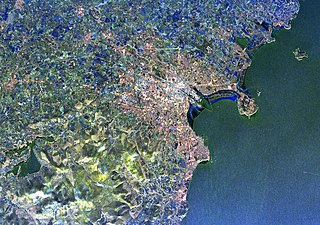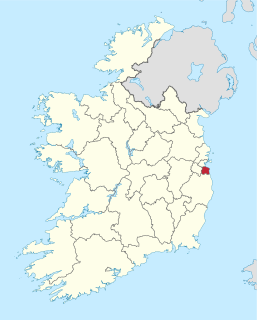Related Research Articles

County Dublin is one of the thirty-two traditional counties of Ireland, located on the island's east coast, within the province of Leinster. The county is divided into the local government areas of Dublin City, Dún Laoghaire–Rathdown, Fingal and South Dublin. The latter three are counties which were created in 1994, when County Dublin was divided for local government purposes. The four areas are a NUTS III statistical region of Ireland.

Dalkey is an affluent suburb of Dublin, and a seaside resort southeast of the city, and the town of Dún Laoghaire, in the county of Dún Laoghaire–Rathdown in the historic County Dublin, Ireland. It was founded as a Viking settlement and became an active port during the Middle Ages. According to chronicler John Clyn (c.1286–c.1349), it was one of the ports through which the plague entered Ireland in the mid-14th century. In modern times, Dalkey has become a seaside suburb that attracts some tourist visitors.

South Dublin is a county in Ireland, within the province of Leinster and the Eastern and Midland Region. It is one of three successor counties to County Dublin, which was disestablished for administrative purposes in 1994. South Dublin County Council is the local authority for the county. The county contains both dense suburbs of Dublin and stretches of unpopulated mountain. In 2016 it had a population of 278,767, making it the third most populous county in the state.
Dublin County Council was a local authority for the administrative county of County Dublin in Ireland.

Dún Laoghaire–Rathdown is a county in Ireland. It is part of the province of Leinster and the Eastern and Midland Region. It is one of three successor counties to County Dublin, which was disestablished in 1994. It is named after the former borough of Dún Laoghaire and the barony of Rathdown. Dún Laoghaire–Rathdown County Council is the local authority for the county. The population of the county was 218,018 at the time of the 2016 census.

In England and Wales, Northern Ireland, and the Republic of Ireland, an urban district was a type of local government district that covered an urbanised area. Urban districts had an elected urban district council (UDC), which shared local government responsibilities with a county council.

Dún Laoghaire is a parliamentary constituency represented in Dáil Éireann, the lower house of the Irish parliament or Oireachtas. The constituency elects 4 deputies on the system of proportional representation by means of the single transferable vote (PR-STV).

The Greater Dublin Area, or simply Greater Dublin, is an informal term that is taken to include the city of Dublin and its hinterland, with varying definitions as to its extent. As of 2022, its estimated population is 2,073,459. The Dublin Transport Authority Act 2008 defines the Greater Dublin Area as including the counties of Dublin, Meath, Kildare, and Wicklow. The area is defined for transport and strategic planning and is not a formal political unit. The term can also apply more narrowly to the Dublin urban area and nearby suburban towns.

The functions of local government in the Republic of Ireland are mostly exercised by thirty-one local authorities, termed County, City, or City and County Councils. The principal decision-making body in each of the thirty-one local authorities is composed of the members of the council, elected by universal franchise in local elections every five years from multi-seat local electoral areas using the single transferable vote. Many of the authorities' statutory functions are, however, the responsibility of ministerially appointed career officials termed Chief executives. The competencies of the city and county councils include planning, transport infrastructure, sanitary services, public safety and the provision of public libraries. Each local authority sends representatives to one of three Regional Assemblies.
A municipal corporation is the legal term for a local governing body, including cities, counties, towns, townships, charter townships, villages, and boroughs. The term can also be used to describe municipally owned corporations.

The Borough of Dún Laoghaire was a borough on the southern coast of County Dublin, Ireland from 1930 to 1994. Its local authority was the Corporation of Dún Laoghaire.
Dublin County was a parliamentary constituency represented in Dáil Éireann, the lower house of the Irish parliament or Oireachtas from 1921 to 1969. The method of election was proportional representation by means of the single transferable vote (PR-STV).

Dún Laoghaire–Rathdown County Council is the authority responsible for local government in the county of Dún Laoghaire–Rathdown, Ireland. It is one of three local authorities that succeeded the former Dublin County Council on its abolition on 1 January 1994 and one of four councils in the old County Dublin. As a county council, it is governed by the Local Government Act 2001. The council is responsible for housing and community, roads and transportation, urban planning and development, amenity and culture, and environment. The council has 40 elected members. Elections are held every five years and are by single transferable vote. The head of the council has the title of Cathaoirleach (Chairperson). The county administration is headed by a Chief Executive, Frank Curran. The county town is Dún Laoghaire. It serves a population of approximately 206,260.
A municipal district is an administrative entity comprising a clearly-defined territory and its population. It can refer to a city, a town, a village, a small grouping of them, or a rural area.
Dublin Townships was a parliamentary constituency represented in Dáil Éireann, the lower house of the Irish parliament or Oireachtas from 1937 to 1948. The constituency elected 3 deputies to the Dáil, using proportional representation by means of the single transferable vote (PR-STV).
Dún Laoghaire and Rathdown was a parliamentary constituency represented in Dáil Éireann, the lower house of the Irish parliament or Oireachtas from 1948 to 1977. The constituency elected 3 deputies to the Dáil, on the system of proportional representation by means of the single transferable vote (PR-STV).
Rathmines and Rathgar is a former second-tier local government area within County Dublin. It was created as the Township of Rathmines in 1847. In 1862, its area was expanded and it became the Township of Rathmines and Rathgar. In 1899, it became an urban district. It was abolished in 1930, and its area absorbed into the city of Dublin.

The Local Government Reform Act 2014 is an act of the Oireachtas which provided for a major restructuring of local government in Ireland with effect from the 2014 local elections. It merged some first-tier county and city councils, abolished all second-tier town and borough councils, and created a new second tier of municipal districts covering rural as well as urban areas. It also provided for a plebiscite on whether to create a directly elected executive Mayor of the Dublin Metropolitan Area although this provision was not activated. The act was introduced as a bill on 15 October 2013 by Phil Hogan, the Minister for the Environment, Community and Local Government, and signed into law on 27 January 2014 by President Michael D. Higgins. Most of its provisions came into force on 1 June 2014.

An election to Dublin County Council in the electoral county of Dún Laoghaire–Rathdown within Dublin County took place on 27 June 1991 as part of that year's Irish local elections. 28 councillors were elected from 7 local electoral areas on the system of proportional representation by means of the single transferable vote for a five-year term of office. It was one of three electoral counties within Dublin County at this election, the others being Fingal and South Dublin.
Killiney and Ballybrack is a former second-tier local government area within County Dublin. It was created as a township in 1866. In 1899, it became an urban district. It was abolished in 1900, with its area becoming part of the borough of Dún Laoghaire.
References
- ↑ Local Government (Dublin) Act 1930, s. 2: Inclusion of certain urban districts in the city ( No. 27 of 1930, s. 2 ). Signed on 17 July 1930. Act of the Oireachtas . Irish Statute Book .
- ↑ Local Government (Dublin) Act 1930, s. 3: Formation of the Borough of Dun Laoghaire ( No. 27 of 1930, s. 3 ). Signed on 17 July 1930. Act of the Oireachtas . Irish Statute Book .
- ↑ Local Government (Dublin) Act 1930, s. 17: Inclusion of certain rural areas in the City ( No. 27 of 1930, s. 17 ). Signed on 17 July 1930. Act of the Oireachtas . Irish Statute Book .; Local Government (Dublin) Act 1930, 1st Sch.: Added rural area ( No. 27 of 1930, 1st Sch. ). Signed on 17 July 1930. Act of the Oireachtas . Irish Statute Book .
- ↑ Local Government (Dublin) Act 1930, s. 82: Abolition of rural district councils in the County ( No. 27 of 1930, s. 82 ). Signed on 17 July 1930. Act of the Oireachtas . Irish Statute Book .